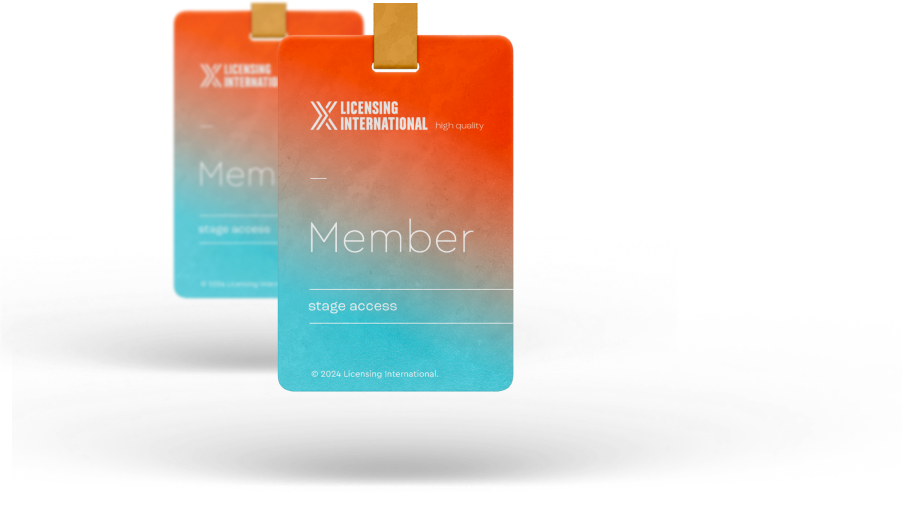Basics and Background
Licensing is a marketing and brand expansion tool that is used globally by everyone from major corporations to the smallest of small businesses. Entertainment, sports, and fashion are some of the best known areas of licensing, but the business reaches into the worlds of corporate brands, art, publishing, colleges and universities, non-profit groups, and more.
Ultimately, brand licensing is a way of doing business that connects you with an ever-widening range of property types, product categories, territories, and demographics.
If you’re looking for the most basic definition, however, a license is an agreement through which a licensee leases the rights to a legally protected piece of intellectual property from a licensor (the entity which owns or represents the property) for use in conjunction with a product or service.

 Entertain/Character (41%)
Entertain/Character (41%) Corporate/Brand (25%)
Corporate/Brand (25%) Sports (11%)
Sports (11%) Fashion (9%)
Fashion (9%) Publishing (6%)
Publishing (6%) Collegiate (3%)
Collegiate (3%) Celebrity (2%)
Celebrity (2%) Music (1%)
Music (1%) Art (1%)
Art (1%) Non (0.6%)
Non (0.6%)
Types of
Licensing
The different types of licensing are not always easily defined, because they often overlap and are constantly evolving to account for technological advancements or changing consumer behaviors. There are, however, categories within the brand licensing business that feature specific patterns in terms of how they are organized and how business is done.
This chart shows the most frequently licensed property types and their relative shares of the reported global licensing industry revenues generated in 2023. Below is a brief description of key industry segments.
Character and Entertainment licensing includes film, television, streaming, video game, and social media properties. (Characters and franchises featured in book are also a popular licensing category but are generally classified as publishing properties.)
This includes everything from an action figure inspired by a popular superhero film to a lunchbox based on a beloved children’s show. This category is the largest in the global brand licensing business, accounting for 41% of sales revenue from licensed merchandise and services worldwide.
Licensing provides opportunities for brand owners to capitalize on the excitement around a film premiere or video game launch but can also be used to keep a property top of mind for consumers in between new content offerings.
The licensing of company names, logos, or brands (referred to as corporate trademarks) is one of the fastest-growing segments of the licensing business.
An increasing number of companies in the corporate sector are building marketing visibility for a core brand by licensing its use in non-core businesses. This type of licensing can protect the company’s trademarks, enhance their brand images, increase their brand exposure, and generate extra revenues and profits. For the brand owner, licensing offers a way to achieve any or all of those goals without making a large upfront investment in internal product development or manufacturing.
Licensing in this sector can include everything from featuring a corporate logo on a t-shirt to much more sophisticated integrated marketing and product development efforts in which a brand is extended into new product areas in ways that are seamless to consumers.
The licensing of fashion brands and designer names cuts across categories like apparel, accessories, beauty products, and home goods.
In some cases, a fashion label only exists as a license—even the “core” apparel categories are licensed to third parties for manufacturing, marketing, and distribution. In these cases, the designer or brand owner is responsible for creating the design direction and marketing strategies that define the brand’s appeal.
In most cases, however, the designer or brand owner creates, markets, and manufacturers core categories and uses licensing as a way of extending the brand into tangential areas such as outerwear, watches, luggage, fragrances, or footwear.
As a result, fashion licensing is often invisible to the consumer. In a well-executed licensing program, the brand owner maintains strict control over design and quality to achieve that seamless brand image.
Sports licensing has grown significantly in scope over the past decade to become the third-largest source of licensing-related revenue globally.
In the U.S., the business is dominated by the four major sports leagues—National Basketball Association, National Football League, National Hockey League, and Major League Baseball—along with racing sports like NASCAR and Formula 1. Other significant licensing campaigns are connected to smaller professional sports leagues (i.e. Major League Soccer, Minor League Baseball), organizations such as the U.S. Olympic Committee and the National Collegiate Athletic Association (NCAA), and major sports events such as the World Cup.
Additionally, colleges and universities around the world are involved in collegiate licensing around their respective sports teams.
The art licensing business is relatively small compared to the other major categories. Art licensing encompasses everything from individual artists who support their artistic endeavors via licensing to well-established businesses that create art and design specifically to decorate a wide range of products, including prints, home décor, housewares, home textiles, publishing, giftware, and apparel. Because of its timelessness, the ability to target specific niches, year-round profit potential, and moderate costs, art licensing is a growing segment of the industry.
Why License?
The use of licensing as a marketing and brand extension tool has expanded significantly over the last 30 years. When well-executed, a strong licensing relationship benefits all parties—brand owners and their agents, licensees and their affiliates, retailers, and consumers—because each of those parties has its own goals that add value to the final product or service.
To maximize the outcome, each participant in the licensing process has certain responsibilities to fulfill. Because every agreement is unique, these responsibilities can vary to some extent.
Brand owners grant licenses to generate revenue from the guarantee and royalty payments, but licensing can also serve a number of other purposes.
Marketing support for the core business: The retail display and proliferation of licensed products not only generates product sales but also promotes the core property. For example, a sports fan wearing a shirt with the logo from their favorite team allows them to express their fandom while simultaneously promoting the team, the league, and the sport to anyone they interact with. Similarly, seeing toys inspired by an upcoming film in stores supports the brand’s overall marketing efforts.
Extending a corporate brand into new categories: Licensing can move a brand into new businesses without making a major investment in new manufacturing processes or facilities. This could include a popular restaurant chain licensing a frozen food manufacturer to market a line of appetizers under its brand or a fashion label licensing its name to fragrances or shoes.
Expanding into new geographical markets with relatively small upfront risk: By licensing its brand to a third-party manufacturer, a property owner can move into new countries with a smaller upfront investment than by building and staffing its own operations.
Maintaining control over an original creation: Licensing represents a way for artists and designers to profit from their creative efforts while maintaining control over how they are used. For brand owners (particularly those doing business in the global marketplace), licensing and registering a brand in multiple markets is a way to protect the brand from being used by others without authorization.
In addition to giving the licensee the right to use the property, the licensor assumes several responsibilities that need to be met to create a successful licensing program.
They Include:
– A timely and efficient approval process, so that products can be developed in a timely way.
– Giving guidance (often in the form of a printed or digital style guide) about how the brand, character, logo, or other IP can be portrayed within the product, on packaging, or in advertising and promotional materials.
– Assisting in marketing activities and, in many cases, helping to sell the brand into retail.
Brand owners must also be aware of the risks involved in licensing, however. It is crucial to find the right partners and to sign agreements that result in products that are of agreed-upon quality, can service the retailer adequately, align with the brand’s goals, and are in service to a true partnership that, when well-executed, is a win-win proposition for all involved.
While licensees traditionally do not share ownership in the brand, leasing the rights to a property for incorporation into their merchandise or services serves several purposes.
Gaining consumer awareness: The most obvious benefit to a manufacturer or service provider that licenses a brand, character, design, or other piece of intellectual property is the marketing power that brands bring to a product. It can take millions of dollars to build a brand from scratch, and licensing represents a way for a manufacturer to take advantage of existing image building and fan engagement. Faced with a choice among several cleaning implements, for example, a shopper might be drawn by one that bears the brand of a well-known cleaning fluid, rather than a more generic label. In making the decision about whether or not to take on a license, a manufacturer often weighs the potential royalty payments against the cost of building a brand on its own.
Moving into new distribution channels: Taking on a license might help a manufacturer whose brand has been marketed in mass merchandise outlets to expand to market an upscale, high-quality line in specialty stores or department stores, for example.
Reducing in-house costs: A manufacturer that licenses artwork or designs to be applied to home textiles, wall coverings, housewares, or on apparel has less reliance on in-house art teams that would otherwise need to be maintained.
Enhancing authenticity and credibility: The publisher of a car-racing videogame might license a host of well-known automotive brands and car models to lend legitimacy and authenticity to the game. Similarly, a maker of automotive parts or accessories will license the car brand to establish in the consumer’s mind that its products will work seamlessly with the cars of the parent brand.
By entering an agreement, the licensee takes on a financial obligation as well as an obligation to adhere to requirements around submitting products for all necessary approvals, creating a product to agreed-upon standards, and marketing the product. The major risk faced by a licensee is financial, including royalties, guarantees, and advances. This is because, even if the products do make it to the market, there is no guarantee that they will do well, no matter what brand a manufacturer chooses to partner with.
Brand owners often retain licensing agents to manage their licensing programs. These agents assume duties for their clients such as contract negotiations or the product approval process. In return, the agent receives a certain percentage of all royalty revenues. For the brand owner, the advantage of retaining a licensing agent involves the agent’s expertise and network of contacts. The brand owner also weighs the cost of the agent against the cost and time involved in building up an internal licensing department to handle the business.
Manufacturers that are involved in brand licensing but who do not have in-house employees to handle the business, on the other hand, may retain a licensing consultant. Consultants represent manufacturers in their licensing activities, including the evaluation of properties or the development and implementation of licensing strategies. The terms under which licensing consultants are paid can vary, but the major percentage is paid in commissions derived from product sales.

Global Licensing
Licensing is a truly global industry. Nations outside the U.S. currently account for more than 40% of the worldwide total of licensed product revenue. As a result, creators of new properties are focused on international appeal as much as possible and the investment in developing and marketing an IP has risen considerably.
Licensing across multiple global markets has important advantages for companies that either cannot or do not wish to invest overseas or export their products. However, before developing multinational campaigns, licensors should keep a number of key issues in mind—including the many cultural, linguistic, legal, and financial differences that exist in different territories.
Thinking globally involves the ability to understand markets beyond one’s own country of origin and requires knowledge of the political and economic situation in the country where a license is to be granted. Of particular importance is the understanding of global consumer behavior as well as knowledge of the prospective licensee and that company’s needs and capabilities.
Entering New Markets
As companies seek to tap into new markets, it is crucial to examine whether the licensing strategies that are effective in one country will also be effective in another region. Differences may exist not only in language and the relative effectiveness of different licensing strategies, but also across market structures, retail patterns, legal systems and limitations, and tax implications.
Before expanding, brand owners need to research the specifics of each country and may want to consult an expert in that territory.









